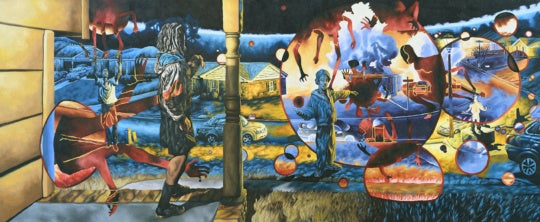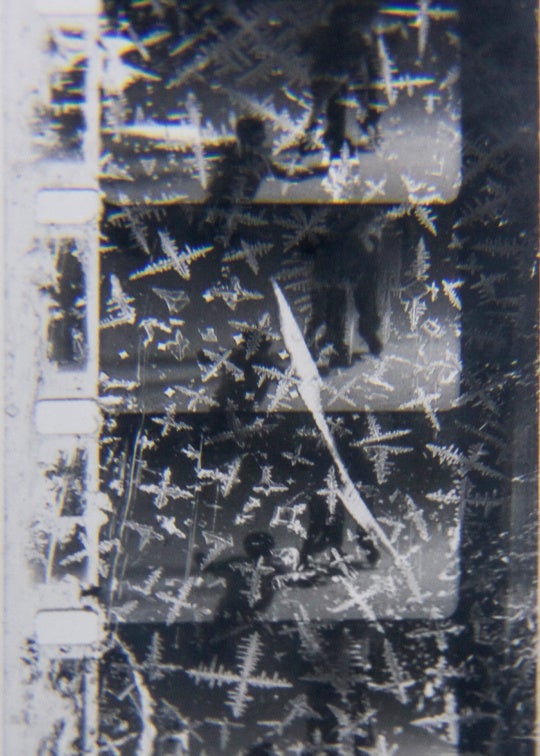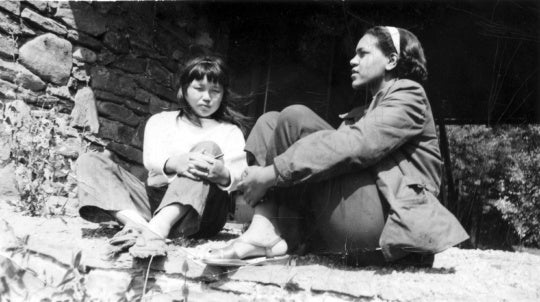
Sergei Isaenko’s exhibition at Dewberry Gallery, Echoes of the Collapse, tells the story of an unnamed soldier who is fighting to preserve memories while moving on from his past. Isaenko tackles this internal struggle frequently in his body of work, which is influenced by his home country, Russia, and his emigration from it. The photographs in Echoes of the Collapse depict a character burdened by a sense of obligation, but conflicted because of how deeply rooted he is in his culture.
The viewer is empathetic to the soldier’s forgotten past, but he is also hopeful for his future. The symbolism of candles adds an element of continuity throughout the photographs, illustrating the lasting flame of his memories and the commemorative nature of the series. The photographs offer a peek into Isaenko’s mind – via an “alter ego” – and follow him on his journey of dejection, introspection, and acceptance.
Instead of internalizing his conflict, Isaenko addresses the issue through his photography. By recognizing the reasons for his emigration, he is able to have peace of mind. The alienation that he felt from his displacement is slowly dissipating, and those old wounds that marred his identity are finally healing.
To further understand the soldier’s story and how it relates to his personal battles and his art, I emailed Isaenko a few questions.
Yves Jeffcoat: In an explanation of your earlier series Stranger, you said that those photographs represent a time when you felt as if you no longer associated with Russian culture, but couldn’t identify with American culture, either. How does Echoes of the Collapse allude to this “in-between state of mind?”
Sergei Isaenko: My Stranger series was a precursor leading to Echoes of the Collapse, where a depersonalized figure lacking identity became the figure of the Unknown Soldier. While working on this project, I was asked if the soldier in the photographs has a name. He does not. For me, he represents a part of myself that has been lost in time. The Unknown Soldier is a reaction to the slow disappearance and loss of my mother culture, a culture that no longer exists. This soldier lives within me still. He is an alter ego who fights to keep a fading memory from dying. For as long as the candle burns, as in A Soldier With No Name, that part of me will always exist.

YJ: How has the inclusion of your family in Echoes of the Collapse helped you “come to terms with” your immigration to the United States?
SI: When I first envisioned a figure of the Unknown Soldier, I realized that the story was not just about him. The project evolved to include all my immediate family members in order to tell the story of a family dealing with issues of displacement and change.
Working on this project somehow brought us closer together as a family. It was important for me to establish the reasons for our displacement, so that we will always remember the sacrifices and struggles on the road to a better life. The experience of working on Echoes of the Collapse as a family was similar to paying respects or honorably remembering the past.
YJ: Candles are a notable motif throughout this series. In Forgotten Honor, some candles stand tall and brightly lit while others pool into melted lines of wax. Candles are often associated with the ideas of hope, enlightenment, intensity, and the haunting quality of memories. How does the prominence of the candles in your photographs relate to this idea? Do they represent your struggle to preserve your past while simultaneously moving on from it?
SI: Candles are an important symbol in my body of work; lit, broken, extinguished, and melted, they appear throughout multiple performance episodes. Some candles represent a passage of time, while others are indicative of the Russian Orthodox tradition of placing a lit candle under an icon. Timothy Ware, the author of The Orthodox Tradition states: “A burning candle represents the entire life of the faithful, from birth to death. His whole being should gradually be consumed by this divine flame thus marking the end of his earthly life.” In the photograph A Soldier With No Name, a soldier holds a lit candle and stares blankly into the distant light. His gaze is indicative of a “thousand mile stare”—a symptom of post-traumatic stress syndrome experienced similarly by many war veterans. In my images he becomes an icon, an individual who survived traumatic events. In the Russian Orthodox tradition, saints depicted in iconography are always referred to as “the great sufferers,” figures who survived incredible hardships. In this context the soldier in my work becomes a saint, he symbolizes the incredible hardships my family and I went through. In A Soldier With No Name, the soldier is silent, the time has stopped, but the candle continues to burn. When it goes out completely, the memory of this tragic character will cease to exist.

YJ: One of your photos, Empires Rise and Fall, is reminiscent of Raising the Flag on Iwo Jima, the famous war photo. Although to you stand higher than the landscape around you, there seems to be a sense of obligation, discouragement, and hesitation in your downward gaze and the tattered fabric of the flag. This mood pervades the series. What do these photographs tell us about how your story has helped you evolve into the artist you are today?
SI: The mood throughout the photographs in Echoes of the Collapse can be referred to as Russian fatalism—a literary device used in classic Russian literature throughout the past century. It can be characterized as an inevitable acceptance of one’s fate.
An artsATL.com critic and author, Christina Cotter, wrote very precisely about one particular aspect of my photography: The works “summon ideas concerning identity and inclusion vs. exclusion. … Not to take Isaenko’s roots too literally, but the use of light and contrast in these portraits suggests a kind of internal psychological reckoning found in the tragic characters of classic Russian literature.”
In working on this project the most important aspect was to tell my story, tell the story of my family; And being an artist came second. I think that … working on a project of a personal nature will always help one to become a better artist.
YJ: By the time the viewer reaches the photo Absolution from Service, where you stand in a pool of water as your family members ceremonially relieve you of your duty, there is a feeling of closure, as if a burden has been lifted. Now that you have resolved and commemorated the reason for your displacement, how will your future work reflect how you are settling and becoming more comfortable with identity?
SI: Echoes of the Collapse was a much-needed self-assessment, as well as closure. Somehow, this project was a therapeutic experience, which served as a healing agent. I cannot fully answer this question, because I still don’t know how my life is going to evolve after this. But, I am looking into the future with hope and wish to continue my integration and contribution to the new homeland while always remembering the past.
YJ: How are you hoping your viewers will connect with you through this series, which addresses themes that affect many people in the United States?
SI: Aspects of displacement, change, and loss can be seen in the visual metaphors of my work. I believe that essentially everyone has gone through some kind of displacement or change at one point of their life: moving to a new city, state, a new school, a new place of employment. Change and displacement are things we all go through. One does not have to be an immigrant or a refugee to understand where my work is coming from. I suppose my goal is to show what happens when the displacement, change, and loss are at their most extreme—as was the case of my experience.
YJ: Your artwork was included in Shadow Puppets at Georgia State University’s Welch School Galleries. How does showing in such a diverse group compared to showing in a solo exhibition affect the message you intend to reveal in your photos, which are highly narrative?
SI: I think that each photographic episode in Echoes of the Collapse has somewhat of a standalone power. In other words, if seen separately from the whole body of work, the images convey the emotional aspects of my project. To me, these images are like pieces of a puzzle. They function to a satisfactory degree as stand-alone pieces of art, but when brought together in a group they tell the whole story.
I am very curious about how my family is going to experience Echoes of the Collapse because they have never been in an exhibition of this scale before, especially one that contains a story about them.




